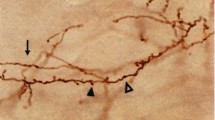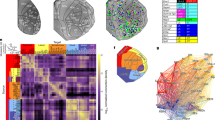Abstract
Afferent columns (>200 μm in diameter) have been intensively investigated in the context of thalamocortical and intrinsic connections. Many extrinsic cortical connections also form columnar terminations, but less is known about their fine organization. Results from intracellular injections of neighboring neurons (in rats: Johnson et al., 2000) suggest that even neurons within a common domain may have non-stereotyped projection patterns, with only partial overlap of terminal arbors. The issue of non-stereotyped projections at the columnar level is further considered by analysis of V1 axons terminating in primate area MT/V5 (an early visual area), and of an axon from temporal cortex terminating in area 7b (a higher cortical area). Both these axons have multiple non-uniform arbors. The implication is that each arbor recruits different numbers and possibly different combinations of postsynaptic elements. While more data are needed concerning convergence of connectional systems, and the actual identity and numbers of postsynaptic targets, the distributed spatial and laminar patterns do not evoke a repetitive uniformity, but rather a columnar substructure and the combinatoric possibilities of the 3-dimensional cortical organization.
Similar content being viewed by others
References
Amir, Y., Harel, M. &; Malach, R. (1993) Cortical hierarchy reflected in the organization of intrinsic connections in macaque monkey visual cortex. Journal of Comparative Neurology 334, 19–64.
Anderson, J. C. &; Martin, K. A. C. (2002) Connection from cortical area V2 to MT in macaque monkey. Journal of Comparative Neurology 443, 56–70.
Anderson, J. C., Binzegger, T., Martin, K. A. C. &; Rockland, K. S. (1998) The connection from cortical area V1-V5: A light and electron microscopic study. Journal of Neuroscience 18, 10525–10540.
Bullier, J. &; Kennedy, H. (1987) Axonal bifurcation in the visual system. Trends in Neuroscience 10, 205–210.
Buzas, P., Eysel, U. T., Adorjan, P. &; Kisvarday, Z. F. (2001) Axonal topography of cortical basket cells in relation to orientation, direction, and ocular dominance maps. Journal of Comparative Neurology 437, 259–285.
Callaway, E. M. (1998) Local circuits in primary visual cortex of the macaque monkey. Annual Review of Neuroscience 21, 47–74.
Defelipe, J. &; FariÑas I. (1992) The pyramidal neuron of the cerebral cortex: Morphological and chemical characteristics of the synaptic inputs. Progress in Neurobiology 39, 563–607.
Elston, G. N. &; Rockland, K. S. (2002) The pyramidal cell of the sensorimotor cortex of the macaque monkey: Phenotypic variation. Cerebral Cortex 12, 1071–1078.
Elston, G. N. &; Rosa, M. G. P. (1997) The occipitoparietal pathway of the macaque monkey: Comparison of pyramidal cell morphology in layer III of functionally related cortical visual areas. Cerebral Cortex 7, 432–452.
Goldman-Rakic, P. S. &; Schwartz, M. L. (1982) Interdigitation of contralateral and ipsilateral columnar projections to frontal association cortex in primates. Science 216, 755–757.
Hof, P. R., Glezer, I. I., Conde, F., Flagg, R. A., Rubin, M. B., Nimchinsky, E. A. &; Vogt Weisenhorn, D. M. (1999) Cellular distribution of the calcium-binding proteins parvalbumin, calbindin, and calretinin in the neocortex of mammals: Phylogenetic and developmental patterns. Journal of Chemical Neuroanatomy 16, 77–116.
Horton, J. C. &; Hocking, D. R. (1998) Monocular core zones and binocular border strips in primate striate cortex revealed by the contrasting effects of enucleation, eyelid suture, and retinal laser lesions on cytochrome oxidase activity. Journal of Neuroscience 18, 5433–5455.
Johnson, D. M. G., Illig, K. R., Behan, M. &; Haberly, L. B. (2000) New features of connectivity in piriform cortex visualized by intracellular injection of pyramidal cells suggest that “primary” olfactory cortex functions like “association” cortex in other sensory systems. Journal of Neuroscience 20, 6974–6982.
Jones, E. G. (2000) Microcolumns in the cerebral cortex. Proceedings of the National Academy of Sciences 97, 5019–5021.
Kennedy, H. &; Bullier, J. (1985) A double-labeling investigation of the afferent connectivity to cortical areas V1 and V2 of the macaque monkey. Journal of Neuroscience 5, 2815–2830.
Kleinfeld, D. &; Delaney, K. R. (1996) Distributed representation of vibrissa movement in the upper layers of somatosensory cortex revealed with voltage-sensitive dyes. Journal of Comparative Neurology 375, 89–108.
KÖtter, R., Stephan, K. E., Palomerogallagher, N., Geyer, S., Schleicher, A. &; Zilles, K. (2001) Multimodal characterization of cortical areas by multivariate analyses of receptor binding and connectivity data. Anatomy and Embryology 204, 333–350.
Kozloski, J., Hamzei-Sichani, F. &; Yuste, R. (2001) Stereotyped position of local synaptic targets in neocortex. Science 293, 868–872.
Lund, J. S., Yoshioka, T. &; Levitt, J. B. (1993) Comparison of intrinsic connectivity in different areas of macaque monkey cerebral cortex. Cerebral Cortex 3, 148–162.
Lund, J. S., Yoshioka, T. &; Levitt, J. B. (1994) Substrates for interlaminar connections in area V1 of macaque monkey cerebral cortex. In Cerebral Cortex, Vol. 10 (edited by Peters, A. &; Rockland, K. S.) pp. 37–60. New York: Plenum Press.
Markram, H., Wang, Y. &; Tsodyks, M. (1998) Differential signaling via the same axon of neocortical pyramidal neurons. Proceedings of the National Academy of Sciences 95, 5323–5328.
Martin, K. A. C. (2002) Microcircuits in visual cortex. Current Opinion in Neurobiology 12, 418–425.
Mccasland, J. S. &; Woolsey, T. A. (1988) Highresolution 2-deoxyglucose mapping of functional cortical columns in mouse barrel cortex. Journal of Comparative Neurology 278, 555–569.
Nakamura, H., Gattass, R., Desimone, R. &; Ungerleider, L. (1993) The modular organization of projections from areas V1 and V2 to areas V4 and TEO in macaques. Journal of Neuroscience 13, 3681–3691.
Rockland, K. S. (1997) Hierarchy revisited: Neuronal substrate of interareal connectivity. In Cerebral Cortex: Extrastriate Cortex in Primates, Vol. 12 (edited by Rockland, K. S., Kaas, J. H. &; Peters, A.) pp. 243–293. New York: Plenum Press.
Rockland, K. S. (2002) Visual cortical organization at the single axon level: A beginning. Neuroscience Research 42, 155–166.
Rockland, K. S. &; Knutson, T. (2000) Feedback connections from area MT of the squirrel monkey to areas V1 and V2. Journal of Comparative Neurology 425, 345–368.
Rockland, K. S. &; Knutson, T. (2001) Axon collaterals of Meynert cells diverge over large portions of area V1 in the macaque monkey. Journal of Comparative Neurology 441, 134–147.
Rockland, K. S. &; Virga, A. (1990) Organization of individual cortical axons projecting from area V1 (area 17) to V2 (area 18) in the macaque monkey. Visual Neuroscience 4, 11–28.
Rockland, K. S., Saleem, K. S. &; Tanaka, K. (1994) Divergent feedback connections from areas V4 and TEO in the macaque. Visual Neuroscience 11, 579–600.
Rouiller, E. M. &; Welker, E. (2000) A comparative analysis of the morphology of corticothalamic projections in mammals. Brain Research Bulletin 53, 727–741.
Selemon, L. D. &; Goldman-Rakic, P. S. (1988) Common cortical and subcortical targets of the dorsolateral prefrontal and posterior parietal cortices in the rhesus monkey: Evidence for a distributed neural network subserving spatially guided behavior. Journal of Neuroscience 8, 4049–4068.
Silberberg, G., Gupta, A. &; Markram, H. (2002) Stereotypy in neocortical microcircuits. Trends in Neuroscience 25, 227–230.
Vogt Weisenhorn, D. M., Illing, R. B. &; Spatz, W. B. (1995) Morphology and connections of neurons in area 17 projecting to the extrastriate areas MT and 19DM and to the superior colliculus in the monkey. Callithrix jacchus. Journal of Comparative Neurology 362, 233–255.
White, E. L. (1989) Cortical circuits: Synaptic organization of the cerebral cortex. Structure, Function and Theory. Boston: Birkhäuser.
Author information
Authors and Affiliations
Rights and permissions
About this article
Cite this article
Rockland, K.S. Non-uniformity of extrinsic connections and columnar organization. J Neurocytol 31, 247–253 (2002). https://doi.org/10.1023/A:1024169925377
Issue Date:
DOI: https://doi.org/10.1023/A:1024169925377




